The massive Pir Panjal range of the Greater Himalaya separates the districts of Kullu and Lahaul-Spiti in Himachal Pradesh. There are a number of rugged passes along this range which the hardy tribals have used since time immemorial- Kugti, Chobia, Kalicho and Rohtang served the residents of Lahaul, while Hamta and Pin Parbat were used by the people of Spiti. Inevitably, with the expansion of the road network and improved connectivity, these passes now witness the passage of only the resilient “gaddis” or the adventurous trekker.
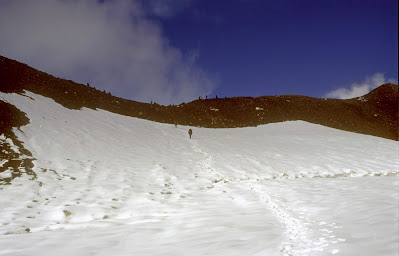
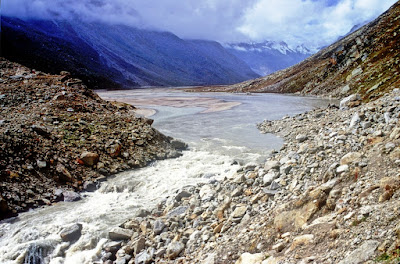
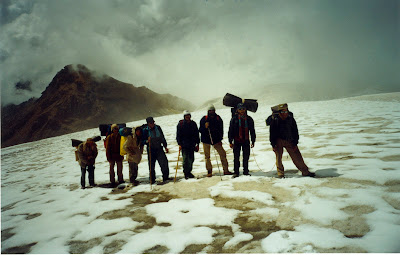
The track from the lake heads east along a narrow, detritus filled valley overhung with glaciers on both sides which feed the lake itself. It ends about three kilometres later at an awe-inspiring feature: a sheer wall of loose rock and moraine, rising straight up 1000 feet at an impossible angle of 70 degrees. It’s difficult to get a firm footing on this slippery slope and one has to inch up one step at a time, keeping a lookout for falling boulders. It takes two hours to reach the top: at 15000 feet the view is stupendous- a 270 degree sweep from the west to the north, an unending array of glaciers, peaks and shimmering streams, all feeding the forbidding lake which we had just left behind.
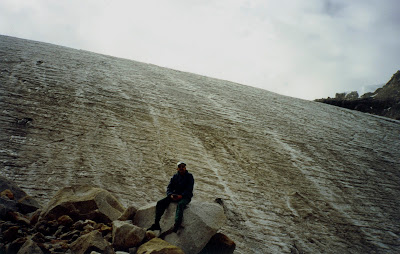
The track continues eastwards from the saddle, along a narrow, scree covered valley floor, through which flows another small stream originating from the glacier atop Pin Parbat itself. We followed this rivulet for a couple of kilometres and then pitched camp for the night- Base camp I.
The next day dawned bright and crisp as only the mountains can offer. We broke camp at 7.00AM, and after a kilometre came to a huge rockfall about 50 meters high which would extend all the way to the pass. The going is tough, but soon relieved by the snout of a massive glacier on the right, at least 150 feet high. It was an awe-inspiring feature as we moved along its foot: it had ice caves and overhangs from which little ribbons of snow melt emerged in hundreds of cascades, all merging into the little stream we were following. Soon we were above the glacier and could now see its huge expanse from the top. It stretched away as far as the eye could see to the south, and it was fractured with hundreds of crevasses. I sometimes wonder if this immense glacier is still there, or if it too has succumbed to the effects of global warming.
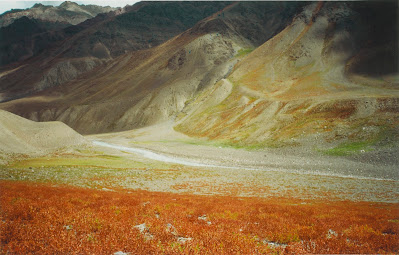
| The author retired from the IAS in December 2010. A keen environmentalist and trekker he has published a book on high altitude trekking in the Himachal Himalayas: THE TRAILS LESS TRAVELLED.
His second book- SPECTRE OF CHOOR DHAR is a collection of short stories based in Himachal that was published in July 2019. His third book was released in August 2020: POLYTICKS, DEMOCKRAZY AND MUMBO JUMBO is a compilation of satirical and humorous articles on the state of our nation. His fourth book was published in July 2021. INDIA: THE WASTED YEARS – chronicles all the missed opportunities in the last nine years. His fifth book – THE DEPUTY COMMISSIONER’S DOG AND OTHER COLLEAGUES – released in September 2023, portrays the lighter side of life in the IAS and in Himachal. He published his sixth book, DISAPPEARING DEMOCRACY-DISMANTLING OF A NATION in March 2024; it is a commentary on events from 2021 to the present, a sequel to THE WASTED YEARS. Shukla writes for various publications and websites on the environment, governance and social issues. He divides his time between Delhi and his cottage in a small village above Shimla. He blogs at avayshukla.blogspot.com |

